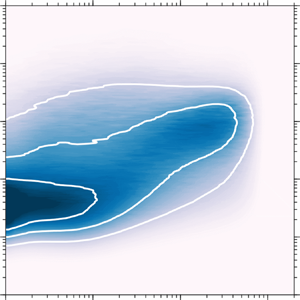Article contents
Spanwise velocity statistics in high-Reynolds-number turbulent boundary layers
Published online by Cambridge University Press: 02 March 2021
Abstract

Spanwise velocity statistics from high-Reynolds-number turbulent boundary layers are reported. The dataset combines efforts spanning over a decade at the University of Melbourne to accurately capture Reynolds number ( $Re$) trends for the spanwise velocity, nominally over one order of magnitude change in
$Re$) trends for the spanwise velocity, nominally over one order of magnitude change in  $Re$, using custom subminiature cross-wire probes that minimise spatial resolution effects and misalignment errors. The spanwise velocity (
$Re$, using custom subminiature cross-wire probes that minimise spatial resolution effects and misalignment errors. The spanwise velocity ( $v$) variance is found to exhibit an
$v$) variance is found to exhibit an  $Re$ invariant logarithmic slope in the log region, in a similar manner to the streamwise velocity (
$Re$ invariant logarithmic slope in the log region, in a similar manner to the streamwise velocity ( $u$), which is consistent with the existence of self-similar features within wall-bounded flows. However, unlike the
$u$), which is consistent with the existence of self-similar features within wall-bounded flows. However, unlike the  $u$-variance, it appears that the logarithmic
$u$-variance, it appears that the logarithmic  $v$-variance trend continues to extend towards the wall. The increase in the
$v$-variance trend continues to extend towards the wall. The increase in the  $v$-variance with
$v$-variance with  $Re$ in the log region is found to be due to ‘intermediate-scale eddies’, which follow distance-from-the-wall scaling. This results in the
$Re$ in the log region is found to be due to ‘intermediate-scale eddies’, which follow distance-from-the-wall scaling. This results in the  $v$-spectrogram exhibiting a dominant energetic ridge across the intermediate-scales, a trend that is not clearly observed in the
$v$-spectrogram exhibiting a dominant energetic ridge across the intermediate-scales, a trend that is not clearly observed in the  $u$-spectrogram. Other features of the
$u$-spectrogram. Other features of the  $v$-spectrogram are found to be similar to the
$v$-spectrogram are found to be similar to the  $u$-spectrogram, such as showing small-scale near-wall features that scale universally with viscous units, and the influence of large-scale
$u$-spectrogram, such as showing small-scale near-wall features that scale universally with viscous units, and the influence of large-scale  $v$ signals residing in the log region that extend to the wall, resulting in a large-scale
$v$ signals residing in the log region that extend to the wall, resulting in a large-scale  $v$ footprint in the near-wall region. The observed behaviour of the
$v$ footprint in the near-wall region. The observed behaviour of the  $v$-spectrogram with changing
$v$-spectrogram with changing  $Re$ is used to construct a model for the
$Re$ is used to construct a model for the  $v$-variance based on contributions from small-, intermediate- and large-scales, leading to a predictive tool at asymptotically high
$v$-variance based on contributions from small-, intermediate- and large-scales, leading to a predictive tool at asymptotically high  $Re$.
$Re$.
- Type
- JFM Papers
- Information
- Copyright
- © The Author(s), 2021. Published by Cambridge University Press
References
REFERENCES
- 11
- Cited by



